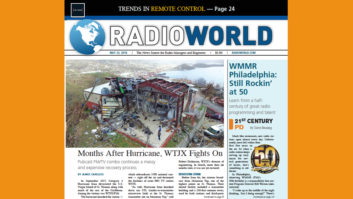In September 2017, Category 5 Hurricane Irma devastated the U.S. Virgin Island of St. Thomas along with much of the rest of the Caribbean. Among the victims was WTJX(FM).

The hurricane knocked the station — which rebroadcasts NPR national content — right off the air and destroyed the facilities of sister PBS TV station WTJX.
“As well, Hurricane Irma knocked down our STL (studio-to-transmitter microwave link) at the St. Thomas transmitter site on Mountain Top,” said Robert Dickinson, WTJX’s director of engineering. In March, more than six months later, it was not yet restored.
DEVASTATING STORM
Before Irma hit, the stations broadcast from Mountain Top, one of the highest points on St. Thomas. Their shared facility included a transmitter building and a 250-foot antenna tower, used by both stations and third-party clients, and a 100-foot auxiliary/STL tower. The site was backed up by a 190 kW main generator and a small 8 kW unit used with the station’s mobile production unit.
The STL was connected to the TV station’s offices/studios on the southwest on 158-158A Haypiece Hill. The FM had offices there and used the TV’s studio to record promos.
Hurricane Irma devastated this facility, gutting the TV production studio down to its massive steel support girders and even damaging some of them. Add wind and rain damage to the rest of the facility, and “our St. Thomas office/ TV studio was destroyed,” said Tanya-Marie Singh, WTJX’s chief executive officer.

Up on Mountain Top, “Hurricane Irma knocked down our 100-foot tower, and severely damaged the 4.5 meter Ku-band satellite dish we used to downlink NPR via satellite,” said Dickinson. To make matters worse, the main generator developed issues that couldn’t be fixed without parts coming from the U.S. mainland, which wasn’t going to happen soon. As well, the station’s 8.1 meter dish that provided the downlink for PBS TV programming was seriously damaged.
On St. Croix to the south, WTJX(FM)’s offices had survived because Irma skirted the island. But although the station had purchased equipment for a production studio, it was not ready to go to air. Besides, “With the STL down on Mountain Top, there was no way for us to link this studio to the transmitter,” Dickinson said. “And with telephone, power and internet down all over St. Thomas, there was no way to create a backup path to the transmitter.”
MAKING DO
Determined to get the FM station back on air as soon as they could, Dickinson and his staff made adjustments to an old 3.8 meter dish so that it could receive the NPR satellite feed on C-band. Given that this antenna was an abandoned Ku-band dish, this was no small accomplishment.
Add the lack of adequate landline and generator power, and it took nearly two weeks to get WTJX back on air with national NPR programming.
When Radio World spoke to WTJX in late March, station staff reported that the St. Croix radio studio had yet to be activated. “We are still without an STL connection between Mountain Top and St. Croix,” Dickinson said. “Meanwhile, using an internet connection hasn’t been an option until recently, due to the island’s internet being down.”

As a result, WTJX listeners were still unable to get local content on the U.S. Virgin Islands’ NPR station. But still, having access to a national NPR feed was a welcome relief for many.
MAKING PROGRESS
Faced with a difficult post-Irma recovery, WTJX did what it could to get local content out by other means.
As of February, “The station has managed to put out regular airings of its ‘Full Circle’ public affairs program via Livestream (on the web) … and rebroadcast the legislature’s LegiTV streaming coverage of both the State of the Territory and the legislature’s response,” according to an article in the U.S. Virgin Islands Daily News.
As for replacing the St. Thomas production facility, Singh estimates that it would cost $15 million to $20 million to build a new office/studio tough enough to weather the next Category 5 hurricane.
“I’m looking at trying to get the power up at our facility, power, water, fiber underground,” she told the Daily News. “I’m hoping to make this station completely resilient. That’s what we’re hoping we can do.”

Dickinson, in his interview with Radio World, expressed gratitude to NPR and PBS for coming to St. Thomas and helping out.
“NPR sent down a crew and supplies to replace the 4.5 meter dish, which we are now using on again to downlink NPR network programming,” he said. Meanwhile as of late March the TV station was back on air, though the 8.1 meter dish was damaged “and is limping along,” Singh said. “We are working with PBS and General Dynamics to get it fully restored.”
Looking ahead, WTJX’s priority is to create some sort of temporary production facility on St. Thomas close to Mountain Top, so that it can produce programming related to the 2018 elections. In particular, Singh wants local candidates to be able to make their cases over the air to voters. “Everyone needs a chance to be heard,” she said.
As for the long term? Raising millions for a new facility in St. Thomas is going to be a daunting task for the stations. To help out, NPR “Fresh Air” host Terry Gross recorded some fundraising PSAs, and the company advertised for a new director of development and fundraising to get things going. Singh herself is hoping that a combination of FEMA funds and public donations will be sufficient to put WTJX back on its feet.
“Relatively speaking, we’re in okay shape, but we have a massive amount of work ahead of us,” said Singh.







